Our closest neighboring planet, Venus, is not a place you’d like to visit. Scorching surface temperatures, an atmosphere so dense it would crush your bones, and acid thunderstorms. It’s about as far from a life-friendly planet as you could get. But, a NASA research team proposes that Venus’ hellish surface used to be very comfortable and pristine — up until some 700 million years ago.

“Both planets probably enjoyed warm liquid water oceans in contact with rock and with organic molecules undergoing chemical evolution in those oceans,” David Grinspoon at the Planetary Science Institute in Tucson, Arizona told Aviva Rutkin at New Scientist.
“As far as we understand at present, those are the requirements for the origin of life.”
Venus has all the makings of a planet that should sustain life: it’s very similar in size, density, and chemical composition to our own planet. Its proximity to Earth further suggests that the two planets were formed from the same primordial materials.
“Venus also has an unusually high ratio of deuterium to hydrogen atoms, a sign that it once housed a substantial amount of water, mysteriously lost over time,” says Rutkin.
But at surface level, the two planets couldn’t be more different. Venus is the hottest planet in the Solar System, so hot in fact that rainfall on the planet evaporates before reaching the ground. This is probably for the best as it rains sulphuric acid, not water, on Venus. Its lightning-and-greenhouse-gas-choked atmosphere is dense enough that carbon dioxide becomes liquid at ground level, so potential human visitors would have a very pressing need for protection.
Still, researchers believe that Venus wasn’t always the hellish place we see today. A recent NASA study lends weight to this theory, showing that up to 3 billion years ago the planet could have had mild, Earth-like temperatures and bodies of water.
Michael Way and his team from the NASA Goddard Institute for Space Studies simulated four versions of early Venus, each with slightly altered factors — such as length of days, incoming energy from the Sun, etc. Left to cook for a few billions of years, the most promising model evolved to have moderate surface temperatures, dense cloud cover to protect the surface from solar radiation, even snow. This model produces habitable conditions in 2-billion-year stretches and estimates that the planet remained habitable up to 715 million years ago.
One catch is that for the model to work, it requires Venus to have been spinning as slowly as it does today – something that researchers have yet to prove. We know that Earth’s rotation has been steadily slowing down over time, and some researchers argue that the same could be true for Venus.
“If Venus was spinning more rapidly, all bets are off,” said Michael Way.
“But, under the right conditions, “You get temperatures almost like Earth. That’s remarkable.”
If the models are accurate, however, the implications could be huge — a few billion years is more than enough time for life to have evolved on Venus during its milder days. Unfortunately, the Venus of today doesn’t really lend well to searching for clues of long-lost life. And we don’t know why it got this way, we don’t know what or when went wrong.
“It’s one of the big mysteries about Venus. How did it get so different from Earth when it seems likely to have started so similarly? The question becomes richer when you consider astrobiology, the possibility that Venus and Earth were very similar during the time of the origin of life on Earth,” Grinspoon said.
The only way to find out if Venus was ever habitable, if life ever evolved here, to figure out what happened for it to end up as it is, is to go there and poke around — something that NASA is already considering.
The full paper, “Was Venus the First Habitable World of our Solar System?” has been accepted for publication in Geophysical Research Letters.


